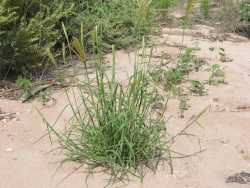Plants perennial; cespitose, sometimes stoloniferous. Culms to 150 cm, herbaceous, solid, glabrous. Sheaths open, rounded; ligules membranous, ciliate, cilia longer than the membranous base, conspicuous tufts of stiff hairs present on either side of the ligules; blades linear, flat or folded. Inflorescences terminal, panicles of non-disarticulating spikelike branches, exceeding the leaves; branches in 1 or more whorl(s), spikelets in 2 rows on the abaxial side of the branches, axes terminating in a functional spikelet. Spikelets laterally compressed, with 2-5 florets, lowest 1-2 florets bisexual, distal 1-3 florets progressively reduced and sterile; disarticulation above the glumes, all the florets falling as a unit. Glumes much shorter than the spikelets, membranous; lower glumes linear, acuminate; upper glumeslanceolate-ovate, awned; calluses bearded; lowest lemmas linear-lanceolate, 3-veined, veins prolonged into 3 awns; central awns 8-12 mm; lateral awns 0.5-12 mm; paleas 2-keeled, acute; distal floret(s) 1-3-awned; lodicules 2; anthers 2 or 3. Caryopses sulcate; embryos 1/2 as long as the caryopses; hila punctate. x = 10. Name from the Latin tri, three, and the genus Chloris, referring to the 3-awned lemmas and the resemblance to Chloris.




